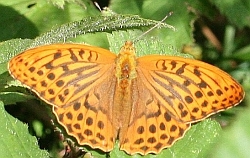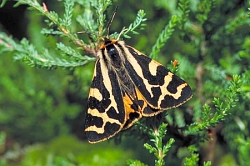Bird spotting walk - 24th June 2006
Event organised as part of the Sponsored Parish Birdwatch
Micheldever Spoil Heaps
Just four attended this meeting, on a hot afternoon when birds were in the minority. The time of year, and the other 'summer' distractions, ensuring that the list of birds crept up to just 19, whereas the invertebrates and botanical specimens totals just continued to climb. Though small in quantity, the birds were good in quality. A calling Willow Tit was the highlight in one respect, this being the 100th bird recorded in the Parish this year!!!
As soon as we left the cars Blackcaps could be heard singing in the dense vegetation flanking the obscure path to the heaps themselves, a family party of Long-tailed Tits soon made their presence known and Woodpigeons were noted overhead.
The 'car park' within the reserve has now mainly been taken over by natural resources and it was here that we found flowering Cut-leaved Germander, a plant that is endangered and found at only a handful of sites throughout Britain; being listed as Category 2 in the Red Data Book. The plants edging the clearing included brambles that were attracting Meadow Browns to nectar and a stunning Silver-washed Fritillary that was the first known of in the Parish.

Left: Silver-washed Fritillary, Argynnis paphia, Bentley Wood, Hampshire - ©Mike Duffy
Several of the smaller moths were disturbed from the vegetation whilst a Large Skipper was feeding on the gaudy Viper's Bugloss, one of the native Echiums. Several sawfly larvae were found feeding, their caterpillar-like looks not being expected by some.
As we walked the 'path' to the spoil heaps Common Gromwell, Enchanter's Nightshade, Ploughman's Spikenard and Pyramidal and Common Spotted Orchids were added amongst the mass of green now carpeting the earth. A Jay was heard off to the north where Chaffinch and Blackcap were in song. A Silver-washed Fritillary put in a closer appearance and Meadow Browns were more obvious on once again entering cleared areas where woodland edging was more predominant. A Marbled White also showed on the edge of the woodland, a rich mixture of black, cream and white intricate patterning.
The lack of recent rain made the scaling of the heaps less hazardous than has been the case but for some it was still problematical! The view from the top was worth it however, the now fully leaved Pedunculate Oaks, Silver Birches, Beech, Ash, Field Maple, Sycamore and the thick under-storey of bramble-tangle attracting in birds, including singing Garden Warbler and Bullfinch, and many insects, the latter particularly about the display of flowers. Common Valerian was notable whereas more careful searching was needed to see the miniscule flowers of both White and Black Bryony.
The crowns of the heaps, as well as being sun-covered, held a different range of plants and the insects interacting with them, the harsher habitat keeping most flora cropped and close to the ground, the less well drained areas holding a greater profusion of growth with, again, different species being recorded. Most of the Fly Orchids had all but gone over, the dark flowers now just a shadow of their former glory, noted just a week or so previously. Common Spotted Orchids were still looking good in the 'valleys' between the peaks and Common Twayblade continued to 'hide' in the woodland edges, their nondescript greenness keeping them veiled from most observers. The Birdsfoot Trefoil is the food plant of Burnet Moths and we found several larvae and pupae, the moths to be on the wing in the near future. Another moth, seen in flight, was thought to be something common until it was caught - the closer inspection allowed it to be seen properly and identified as a Wood Tiger, a stunning moth and new for all present.

Right: Wood Tiger, Parasemia plantaginis, Northern Ireland! - ©Robert Thompson
A single Cinnabar larvae clung to a stem and both grasshoppers and crickets were on the move in the shorter vegetation; the former occasionally bursting into song. A Common Groundhopper was found amongst its relatives and showed to inches before disappearing with a huge jump. Of the birds recorded, a singing Chiffchaff was of most note, its repetitive song often however being drowned out by the nearby trains or more boisterous Blackcaps.
Heading towards the woodland south of the heaps saw Squinancywort being found amongst the Wild Thyme and Mouse-ear Hawkweed, Lady's Bedstraw, Fairy Flax, Hairy Rock-cress, Common Rock-rose and Salad Burnet all in flower on the highest, and most exposed, areas of chalk spoil.
Dropping down in to the cooler woodland had more Common Twayblade lining the path edge and being tangled amongst the Dog's Mercury, Cleavers and remnants of both Cowslip and Primrose. A female Slow Worm glided across the path before a closer encounter with group members, another new beastie for at least one of those present.
Both the Greater and Lesser Butterfly Orchids were, as for the Fly Orchids, almost over, the pale white flowers now being almost lost amongst the stronger grasses, the pollen-masses still however being present and allowing positive identification of the two closely related species. Greater stands of Viper's Bugloss partially covered a cleared area that also held Wild Strawberry, Common Ragwort and a mixture of herbs that attracted in a worse-for-wear Common Blue, another Wood Tiger, c.20 minute Cinnabar larvae and another Silver-washed Fritillary, the latter showing well as it glided about the bushes and trees below the edge of the spoil, heap. A further Marbled White was seen, settled and giving excellent views of its striking underwing pattern.
Moving back towards the cars, viewing from the top of the heaps allowed a Nuthatch to be heard and then seen as it crawled about tree trunks and the Garden Warbler to be briefly seen as it continued to bubble away in the thicker thickets. A calling Willow Tit was noted at least twice but remained out of view, unlike the returning family of Long-tailed Tits that put on a show as they moved higher and higher in the trees, remaining however below our own lofty viewing point. A crowing Pheasant was heard in the near distance and two, presumed, racing pigeons headed over rapidly. A single Swallow headed low over the woodland and, on returning to the cars, a Great Spotted Woodpecker called as it flew further into the Parish. A Roe Deer was flushed from thick cover, close to the path but only seen fleetingly on its exit. An extremely solid-looking Mullein Moth larvae was found feeding on Common figwort alongside the path, as for the earlier Cinnnabars, its strong patterning, white with black and yellow spots, warning all possible predators of the nasty surprise they would be in for if they dared to attempt to consume it!
Thanks are due to those that attended. As always, the company of others on these walks makes up a large part of the enjoyment. Their thoughts, observations and questions making the outing progress that much more interestingly. It may have been relatively quiet for birds, but we certainly made up for it!
Thanks are also due to the Hampshire and Isle of Wight Wildlife Trust for allowing us to use their reserve as a venue for one of my walks.
View the complete list of species recorded on the walk.
Return to the list of reportsPeter E. Hutchins
PS. do please be aware that a permit is needed to access the Micheldever Spoil Heaps Reserve. These can easily be obtained by contacting the Hampshire and Isle of Wight Wildlife Trust on 01489 - 774400 or at Beechcroft House, Vicarage Lane, Curdridge, near Botley, SO32 2DP.
